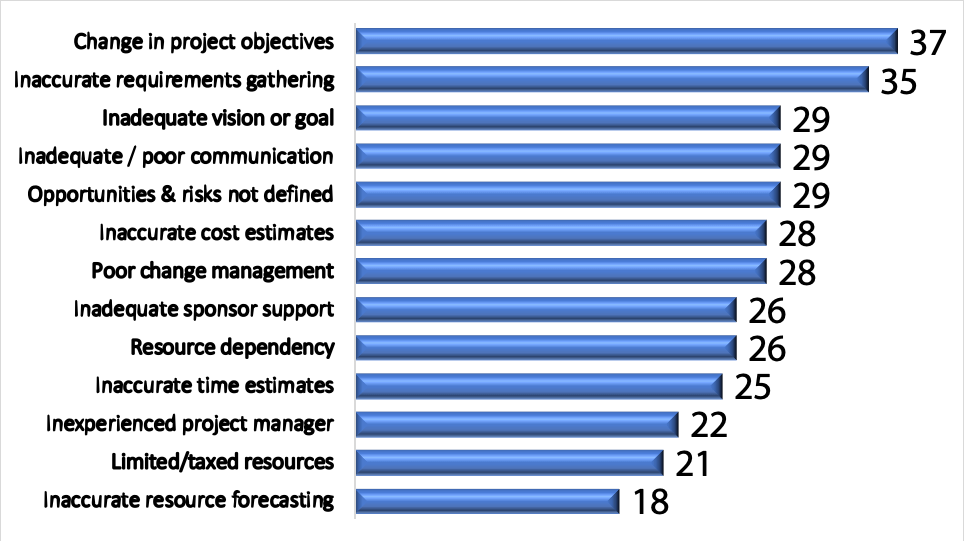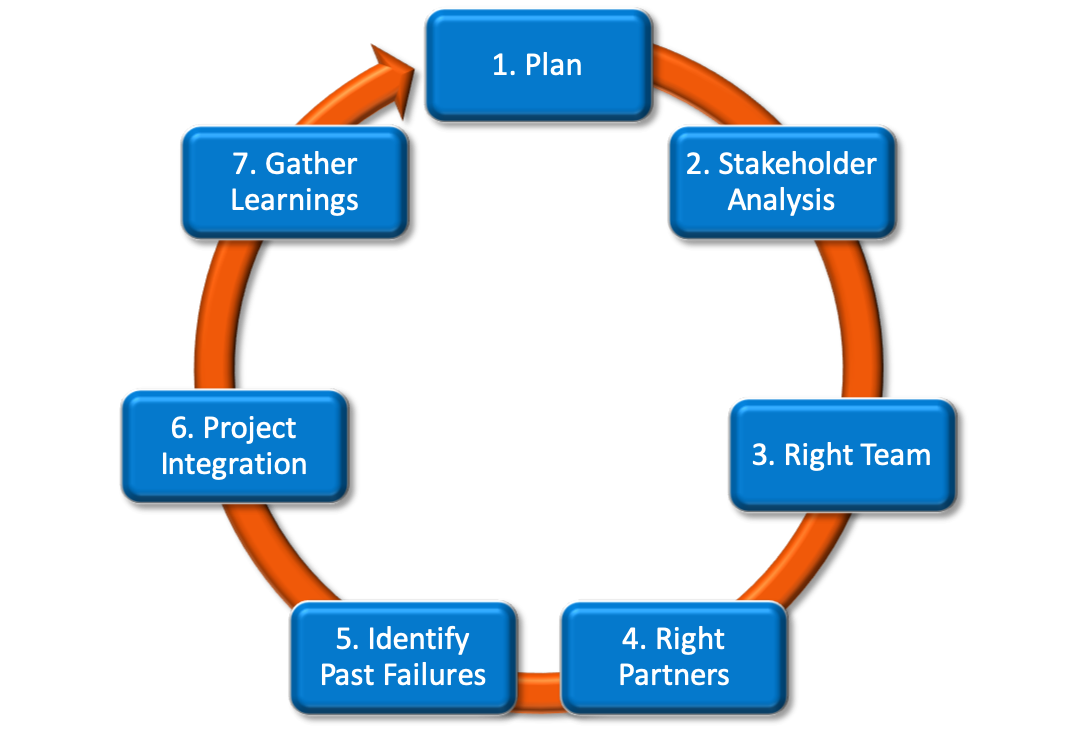I’ve been involved in hundreds of successful project management initiatives over my career. I’ve been the leader, sponsor or team member, which means that each time I had different responsibilities.
What they all had in common was the desire to get the project approved quickly and easily, with the right resources of people, time and money.
There are many reasons why projects fail and I’ve experienced many of them over my career! The one project that stands out in my memory is unfortunately not my best, but one that demonstrates everything that can go wrong! It happened just after I got a new boss. That in itself is not always easy, but our working relationship was made more difficult when he gave me his pet project to run.
My team had the necessary skills to see the project through, but it was not the most adapted to their experience nor preferences. As if that wasn’t bad enough, my new boss obliged us to work with his preferred supplier without running an RFP. (request for proposal)
I didn’t have a very good opinion of the supplier, as not only were they far more expensive than most of the other agencies, but in addition they always seemed to mess things up! It was much later that I learned that the supplier had a particular relationship with my boss, who was receiving a share of every project paid.
The day of the presentation arrives. The supplier has ordered champagne and a huge cake decorated with the names of his company and ours. He is anticipating a successful outcome that we will celebrate together. However, there was no celebration.
You see, his company made a basic mistake in their calculations. The same one in fact as they had made the year before! My boss didn’t tell me about it and the supplier clearly forgot about the previous year’s incident.
Could the project have been a success? Of course it could. If we had followed the seven-step roadmap I am going to share with you now.
Why projects fail
But before sharing how to succeed I want to discuss why projects fail.
According to research undertaken by Forrester, 70% of projects fail! Even the highly rated IBM consultants fail 60% of the time. Only 2.5% of companies successfully complete all their projects! So why do so few succeed and so many fail?
[/signinlocker]
Another piece of research, this time from Workamajig, shows that more than a third of IT projects fail due to changes in objectives or inaccurate gathering of requirements. More than a quarter fail because of an inadequate vision, or risk assessment, poor communications, budget estimates or other lack of resources. All of these should be covered in the primary planning phase of a project, which clearly shows poor change management.

There are many reasons why projects fail; I like to summarise them as the 3Ps:
PLANNING
Planning, or to be more precise, a lack thereof. We all know the infamous quote
“Failing to plan is planning to fail”
And yet we continue to jump into action before really knowing what our actions should involve. Time spent planning is time well spent.
Think about playing chess. Beginners contemplate on their next move, but champions think about their next three to five moves. The same should apply to project planning. Considering what might go wrong before it happens, means we are prepared for alternative actions and thus our project is not delayed while we search for a solution.
Another problem with planning is accepting shorter, usually unrealistic deadlines. Sometimes we are asked to add other elements to the project and when these requests come from senior management, we feel compelled to accept.
But there is a better way. Accept the new deadlines only with increased resources. If timing is cut, then we need extra people and budget in most cases to complete the project. Ask for them before agreeing to shorter deadlines. As another infamous quote says
“Under promise and over deliver”
A third challenge in planning follows on directly from unrealistic deadlines and it is scope creep. As with the previous example, we again should ask for increased resources. An even better solution is to note the additional requests and then suggest that they form a separate project or are addressed once the first project is completed.
PEOPLE
The second P of project failure is people. People are the cause of many management challenges not just in project teams! But issues do seem to be more critical in keeping a project advancing as planned when there are issues.
I believe that project teams are usually made up of people chosen by the project leader and are often used for various projects with different objectives. A better way to form a project team is to choose members based on the needed skills. This clearly means that teams will be different for each project.
The next challenge is to get everyone to work together. The leader must clearly valorise each member so that everyone knows the expertise of each and why they are there. Problems can sometimes arise when more than one member has the same skill set and disputes arise. While disagreements are not necessarily a bad thing, it does help if there is one person who is the lead expert on each topic. This way they can have the final say on an issue, as otherwise it falls to the leader to decide, which makes the team feel less valued.
The third challenge with people is communicating effectively. Not only does the team need to exchange ideas and work well together, they must also communicate with those outside the team, including the many stakeholders. This can become a delicate issue at the best of times, but becomes critical when the project is not going well.
Communications can be particularly challenging with a virtual team. Members often don’t know what others are doing, so there is a lot of waste in both expertise and experience.
Monthly meetings for local members plus regular calls with remote members, grouped by time Zones, is a minimum. These connections are particularly valued by smaller, emerging markets, which most people in larger organisations ignore and never consult.
PROCESS
The first process problem is isolation. Working in isolation, whether for the team leader or the team as a whole, will usually result in wasted effort. This is particularly true for multi-departmental or multi-country projects.
The second area involves data gathering. Often the information you get is in different formats when coming from different sources. You may also find similar information coming from multiple sources and you have to make the difficult decision as to which is the most reliable.
We all gather information that fits our precise needs, which can explain some of the differences. Again a review and comparison will usually highlight the best data for your project’s objectives.
When I first started consulting almost a decade ago, a leading CPG company asked me to help their marketing team get board approval to create a global consumer database. This was ten years ago, so they were certainly ahead of most businesses at that time.
Their thinking was dominated by their project. Mine wasn’t. In conducting an audit of current internal processes and gathering global suggestions, I discovered three other projects already in progress that would impact or be impacted by our project.
In addition, one was actually reworking all the company’s product definitions and SKU names & groupings. We could have done our project in isolation and repeated the same exercise!
Integration of the two projects made ours better and more important. It also freed resources for one part of our project, which made it easier for the board to give their approval.
The third aspect to help prevent process failures is to ensure learnings are recorded. These are invaluable, not only for the current, but even more important for future projects.
In my opening example, we could have avoided the disaster if the supplier had recorded the error they had made the previous year. They didn’t. And my boss didn’t warn me and my team, so we were not looking out for it.
The 7-Step Roadmap
Here is the recommended project process to use. Note that it is a circle not a line, as learnings will be fed into future projects, as already mentioned. Projects also should never be treated in isolation.

#1 PLAN
One of the most well-known quotes about planning is this one:
Failing to plan is planning to fail
We all know we should plan first, but we are also all very keen, especially at the beginning of a project, to start getting into the actions.
One of the most useful suggestions about starting a project comes from none other than Albert Einstein. He is quoted as having said that if he had one hour to save the world he would spend
Fifty-five minutes defining the problem and only five minutes finding the solution.
Now I’m not suggesting that we spend almost all our allotted time on defining the objectives, but I know we could all benefit from spending more time doing so. How long do you spend before jumping to action?
#2. STAKEHOLDER ANALYSIS
We usually need an executive sponsor for our projects, but that doesn’t mean that other managers should not be informed about the project. Their opinions can help define the project early on and they are more likely to support you when involved. Their input may even improve the quality of the project and help you to acquire more resources.
Building support early and often, can ensure that any risks are anticipated and planned for. Understanding your stakeholders also means you are more likely to predict their reactions as the project develops.
Not all stakeholders are of equal importance. You, therefore, need to identify which ones are the most important for your project and plan your communications accordingly.
The simple matrix analysis below is an effective way of identifying whom to inform, how often and with what information.
 The position that you allocate to a stakeholder on the grid shows you the actions you need to take with them:
The position that you allocate to a stakeholder on the grid shows you the actions you need to take with them:
High power, high interest: fully engage them and make your greatest efforts to satisfy them.
High power, less interest: keep them satisfied, but not so much that you overwhelm them with information so that they become bored with your messages.
Low power, high interest: adequately inform them. As they are interested, talk to them to ensure that there are no major issues arising. They can also be very helpful in finding and sharing information about your project with other departments.
Low power, less interest: monitor but don’t irritate them with excessive communication.
Who would you put in the top right-hand corner for your own projects? Do they vary by project? Of course they do, so always run an analysis for each new project you run.
One analysis I ran for a project I led, helped me to identify the best sponsor for it. I found that one regional president was new in the position and was keen to make his mark. It was therefore easy for me to convince him to support my project and he, in turn, found a market to beta test the system before rolling it out worldwide. Talk about a win-win!
#3 & 4 GETTING THE RIGHT TEAM & PARTNERS
I have put these two steps together as there are a number of similarities. It’s about getting the right people to support you with your project.
Internally, you need to hire for skills. Many project teams don’t work because the leader chooses team members based upon their relationships with them. While this may make for a fun project, it may not lead to success. There may be an overlap of skills, or some may be lacking. Therefore always choose skills first and people second.
For external partners, you can be tempted by a similar bias. Therefore you go for the big consultancies that your board knows. Some executives may even oblige you to work with certain agencies, as was the case in my example at the beginning.
While big consultancies may impress by their professional pitch given by one of their partners, it is unlikely that that particular expert will have anything more than a cursory involvement in your project. So don’t be impressed by their slick presentation, alone.
Sometimes (often) it makes more sense to hire a smaller, boutique agency that has the precise skills you need. You are more likely to get the involvement of the people you meet during the pitch, and small usually also means agile, creative, and a more personalised service. Keep that in mind.
#5 IDENTIFY REASONS FOR PAST FAILURE
As a part of your pre-project planning, I suggest you find the last 5-10 projects that failed in your organisation, ideally in your own department. Then find out why they failed and match those reasons to your project, both similarities and differences.
For each, identify what you will do differently to achieve a successful project management. You can also check on social media for comments and questions that are relevant, especially in Facebook groups and on Quora.
#6 UNCOVER & INTEGRATE PROJECTS
Undoubtedly, there are other projects planned or running at the same time as yours, in your organisation. You therefore need to find them and see whether integration makes sense.
As in the example mentioned earlier, if there is a need in your company, someone is probably working on a solution or about to start. Take advantage of working together and pool resources as needed. Another easy win-win.
#7 GATHER LEARNINGS
You should record learnings the whole way through the project, from start to finish. So many teams sit down at the end of a project and try to remember what went well and what went badly. If you do this you will miss so much!
At the end of the project, gather all the learnings that have been recorded and have the team discuss and note the most useful of them and why. That way the risks and opportunities will be more quickly identified and can be easily input into the next project you run.
Conclusions
The title of this article refers to getting approval for your project. If you follow this roadmap, not only will you succeed in your project management, but you will also be seen to do so as well. It will make future projects all that much easier to get approved and you might even get yourself a promotion in recognition of your great management and organisational skills!
This 7-step process is a virtuous circle and it starts and ends with planning. My suggestion is therefore to plan, plan, plan – and then plan some more!
If you would like some help in running your own projects or in better understanding this process, then reach out at [email protected], I’m always here to help you.












